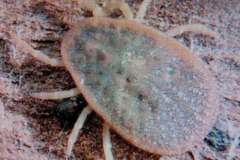As the guiding principle for what we include in CHAS Notebook pages has been to focus on what we can see, the Argas Reflexus hardly qualifies, in that it is less than 10 mm long and was last seen in the Cathedral in 1999.
This is a small tick (Image 1) which was long thought to exist in England only at Canterbury – hence its common names include Canterbury tick or Bell Harry Bug. It flourishes in the Middle East and continental Europe, and its main host is the domestic pigeon. In England it has been found in Canterbury cathedral (details below), Rochester castle and Kings College Cambridge. The bite in humans may cause itching or allergic reactions. It can apparently survive for long periods (several years) without sustenance. The colouring of the tick is variously described as brown or grey; according to the British Medical Journal (1914) it can appear in some lights ‘yellow and white.
Canterbury cathedral sightings include the following:
- in the 1850s a large colony was found in a wall under repair – the ticks survived in a box without water or food (or blood!) for five years
- in 1871 a Canterbury cathedral specimen was reported by Roger Gulliver to the East Kent Natural History Society
- in 1917 – an example from Canterbury cathedral was sent to the Natural History Museum
- in 1950s one tick was found by Canon John Bouquet in St Anselm chapel
- in 1963 one tick was found and reported in the New Scientist
- in 1981 a dead specimen was found during the restoration of stained glass from the Trinity chapel – this could apparently have been trapped in the window hundreds of years ago (Image 2)
- in 1999 a live version was found in the Dean’s chapel by Peter Brett and reported in the Canterbury cathedral Chronicle magazine with historical background
Sources: Lang-Sims (1979); Warner (1923); also article by Peter Brett ‘Argas Reflexus is alive and well’ in Chronicle 1999; British Medical Journal vol. 2 no. 2811 (14 November 1914) p. 830-1; Journal of East Kent Natural
History Society 1872 p.205-6; article by A E Shipley ‘Insects and war : ticks’ in New Scientist 19 September 1963 p. 595
DL


